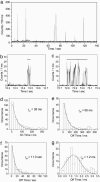Reversible single-molecule photoswitching in the GFP-like fluorescent protein Dronpa
- PMID: 15972810
- PMCID: PMC1157093
- DOI: 10.1073/pnas.0500489102
Reversible single-molecule photoswitching in the GFP-like fluorescent protein Dronpa
Abstract
Reversible photoswitching of individual molecules has been demonstrated for a number of mutants of the green fluorescent protein (GFP). To date, however, a limited number of switching events with slow response to light have been achieved at the single-molecule level. Here, we report reversible photoswitching characteristics observed in individual molecules of Dronpa, a mutant of a GFP-like fluorescent protein that was cloned from a coral Pectiniidae. Ensemble spectroscopy shows that intense irradiation at 488 nm changes Dronpa to a dim protonated form, but even weak irradiation at 405 nm restores it to the bright deprotonated form. Although Dronpa exists in an acid-base equilibrium, only the photoinduced protonated form shows the switching behavior. At the single-molecule level, 488- and 405-nm lights can be used to drive the molecule back and forth between the bright and dim states. Such reversible photoswitching could be repeated >100 times. The response speed to irradiation depends almost linearly on the irradiation power, with the response time being in the order of milliseconds. The perfect reversibility of the Dronpa photoswitching allows us to propose a detailed model, which quantitatively describes interconversion among the various states. The fast response of Dronpa to light holds great promise for following fast diffusion or transport of signaling molecules in live cells.
Figures





Comment in
-
Reversible molecular photoswitches: a key technology for nanoscience and fluorescence imaging.Proc Natl Acad Sci U S A. 2005 Jul 5;102(27):9433-4. doi: 10.1073/pnas.0504264102. Epub 2005 Jun 27. Proc Natl Acad Sci U S A. 2005. PMID: 15983383 Free PMC article. No abstract available.
References
-
- Irie, M. (2000) Chem. Rev. 100, 1685-1716. - PubMed
-
- Giordano, L., Jovin, T. M., Irie, M. & Jares-Erijman, E. A. (2002) J. Am. Chem. Soc. 124, 7481-7489. - PubMed
-
- Fernández-Acebes, A. & Lehn, J.-M. (1999) Chem. Eur. J. 5, 3285-3292.
-
- Lippincott-Schwartz, J., Altan-Bonnet, N. & Patterson, G. H. (2003) Nat. Cell. Biol., Suppl., S7-S14. - PubMed
Publication types
MeSH terms
Substances
LinkOut - more resources
Full Text Sources
Other Literature Sources

